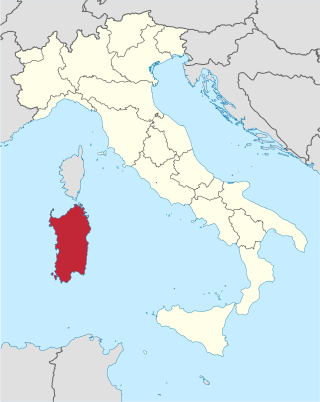
Sardinia is the second-largest island in the Mediterranean Sea, after Sicily, and one of the twenty regions of Italy. It is located west of the Italian Peninsula, north of Tunisia and 16.45 km south of the French island of Corsica.

Cagliari is an Italian municipality and the capital and largest city of the island of Sardinia, an autonomous region of Italy. It has about 155,000 inhabitants, while its metropolitan city has about 420,000 inhabitants. According to Eurostat, the population of the functional urban area, the commuting zone of Cagliari, rises to 476,975. Cagliari is the 26th largest city in Italy and the largest city on the island of Sardinia.

Archaeological evidence of prehistoric human settlement on the island of Sardinia is present in the form of nuraghes and other prehistoric monuments, which dot the land. The recorded history of Sardinia begins with its contacts with the various people who sought to dominate western Mediterranean trade in classical antiquity: Phoenicians, Punics and Romans. Initially under the political and economic alliance with the Phoenician cities, it was partly conquered by Carthage in the late 6th century BC and then entirely by Rome after the First Punic War. The island was included for centuries in the Roman province of Sardinia and Corsica, which would be incorporated into the diocese of Italia suburbicaria in 3rd and 7th centuries.

Città di Castello ; "Castle Town") is a city and comune in the province of Perugia, in the northern part of Umbria. It is situated on a slope of the Apennines, on the flood plain along the upper part of the river Tiber. The city is 56 km (35 mi) north of Perugia and 104 km (65 mi) south of Cesena on the motorway SS 3 bis. It is connected by the SS 73 with Arezzo and the A1 highway, situated 38 km (23 mi) west. The comune of Città di Castello has an exclave named Monte Ruperto within Marche.

The Judicates, in English also referred to as Sardinian Kingdoms, Sardinian Judgedoms or Judicatures, were independent states that took power in Sardinia in the Middle Ages, between the eleventh and fifteenth centuries. They were sovereign states with summa potestas, each with a ruler called judge, with the powers of a king.

Albano Laziale is a comune (municipality) in the Metropolitan City of Rome Capital, on the Alban Hills, in the Italian region of Lazio. Rome is 25 kilometres (16 mi) distant. It is bounded by other communes of Castel Gandolfo, Rocca di Papa, Ariccia and Ardea. Located in the Castelli Romani area of Lazio. It is sometimes known simply as Albano.

Pula is a comune (municipality) in the Metropolitan City of Cagliari in the Italian region of Sardinia, located about 25 kilometres (16 mi) southwest of Cagliari.

The Judicate of Cagliari was one of the four kingdoms or judicates into which Sardinia was divided during the Middle Ages.

Batignano is a small town in southern Tuscany, a frazione of the comune of Grosseto, positioned at about 10 km north-east of the capital on one of the last foot-hills of the valley of Ombrone which dominated the ancient city of Roselle.

Nostra Segnora de Mesumundu is a religious building in the territory of Siligo, Sardinia, Italy.
Santa Igia or Santa Ilia, modern Santa Gilla lagoon, was a city in Sardinia, in what is now Italy, which existed from the 9th century AD to 1258, when it was destroyed by Pisan troops. It was the capital of the Giudicato of Cagliari, one of the kingdoms in which the island was divided in medieval times.
This article presents a history of Cagliari, an Italian municipality and the capital city of the island of Sardinia. The city has been continuously inhabited since at least the neo-lithic period. Due to its strategic location in the Mediterranean and natural harbor, the city was prized and highly sought after by a number of Mediterranean empires and cultures.

The Visconti Castle of Bereguardo, Castello Visconteo of Bereguardo in Italian, is a medieval castle in Via Castello 2, Bereguardo, Province of Pavia, Lombardy, Italy.

Castello di Ocre is a medieval castle in Ocre, Province of L'Aquila, Abruzzo, southern Italy.

The Castle of Sant'Eusanio Forconese is a medieval castle in Sant'Eusanio Forconese, Province of L'Aquila, Abruzzo, southern Italy.

The Byzantine age in Sardinian history conventionally begins with the island's reconquest by Justinian I in 534. This ended the Vandal dominion of the island after about 80 years. There was still a substantial continuity with the Roman phase at this time.

The Sardinian Romanesque is the Romanesque architectural style that developed in Sardinia. The Romanesque architecture in Sardinia has had a remarkable development since the early origins, during the Giudicati era, and for a long period. His expressions, although autonomous, are not classifiable in a recognizable image, since in the island the Romanesque manifested itself with unusual results but in numerous forms; this is due to the establishment in Sardinia of several religious orders, coming from various Italian regions and from France. Consequently, in the architectures of that era Pisan, Lombard and Provençal influences are recognizable as well as traces of the passage of workers, coming from the Iberian Peninsula, of Islamic culture. In total there are over 150 Romanesque monuments in Sardinia.

The Visconti Castle or Castello Visconteo of Cassano is a castle of medieval origin in Cassano d'Adda, Lombardy, Northern Italy. Its current form dates back to the 14th century, when Bernabò Visconti, lord of Milan, enlarged the existing fortification as part of a defensive system of the Visconti dominions on the Adda river. At the end of the 20th century, after a period of abandonment, it was restored and transformed into a hotel.
Architecture of Sardinia has developed since 4000 B.C., presenting characteristic aspects in certain historical periods, especially in the Nuragic age.

















